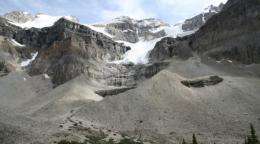500 million year old fossils discovered on new site

During an expedition into the Canadian Rocky Mountains in 2008, a Canadian-led team including Swedish researchers from Uppsala University found a new site with exceptionally preserved fossils. The site and its fossils have now been made public in this month's issue of Geology.
The discovered fossils, including a new form of giant predator, are equivalent in age to the world-famous Burgess Shale. However, the sediments of the new site have been deposited in an entirely different environment than the Burgess Shale, where nobody would have expected such exceptional preservation.
Following reports by hikers of unusual fossils in the Stanley Glacier area of Kootenay National Park (British Columbia, Canada), a 2-week expedition was initiated by the Royal Ontario Museum (Toronto, Canada) in 2008 to investigate the area. On board the team of five scientists led by Jean-Bernard Caron (ROM) were Uppsala researchers Allison Daley and Michael Streng. The discoveries made, after just a few days, were far beyond the expectations of any team member.
Hundreds of fossils were found at Stanley Glacier, including eight completely new animals and dozens of beautifully preserved specimens of arthropods, brachiopods, trilobites, molluscs, and sponges. A photograph of a particularly well-preserved sponge called Diagoniella was chosen to adorn the front cover of September’s issue of Geology. One of the new animals, Stanleycaris, belongs to a group of monster predators called the anomalocaridids. These creatures were up to one meter in length and had a segmented crayfish-like body with spiny head appendages and a circular mouth with sharp teeth; they were undoubtedly the most formidable predators of the Cambrian seas. Also found at Stanley Glacier is a wide multi-segmented arthropod similar to an animal from the Chengjiang biota of China but found for the first time in North America, and the first example of the elusive appendages of Tuzoia, a Cambrian arthropod previously only known from its spiky body shield and large eyes.
Although the new site is part of the same rock unit the Burgess Shale belongs to, the discovery of such spectacular fossils at Stanley Glacier was a complete surprise. The ancient ocean, in which the rock unit was deposited ca. 505 Ma ago, was characterized by a submarine cliff called an escarpment that divided the area in a deep basin and a shallow shelf. This escarpment was thought to play a decisive role in the remarkable preservation of the Burgess Shale biota, as all previous localities yielding Burgess Shale fossils were found in the deep basin crowded close against the base of the escarpment. The site at Stanley Glacier, however, was deposited in the shallower shelf area above the escarpment. This throws the importance of the escarpment for exceptional preservation into question and opens up many opportunities to find more new fossil sites.
The Burgess Shale (part of the UNESCO World Heritage Canadian Rocky Mountain Parks) and its exceptionally preserved fossils present a remarkable snapshot of Cambrian marine life. It celebrated its 100th anniversary of discovery last year, and new important research discoveries continue to emerge from this site, and new sites such as Stanley Glacier. Other recent discoveries include a primitive squid-like organism Nectocaris (Smith and Caron, 2010, Nature), and another new anomalocaridid Hurdia (Daley et al. 2009, Science), showing that this famous fossil site has more secrets to reveal as it enters its second century of research.
More information: A new Burgess Shale-type assemblage from the “thin” Stephen Formation of the southern Canadian Rockies by Jean-Bernard Caron, et al, appears in the September 2010 issue of Geology.
Provided by Uppsala University





















